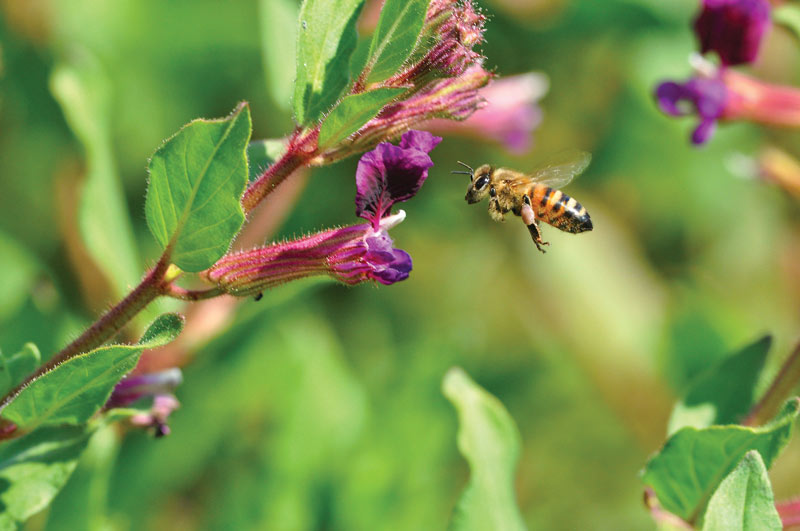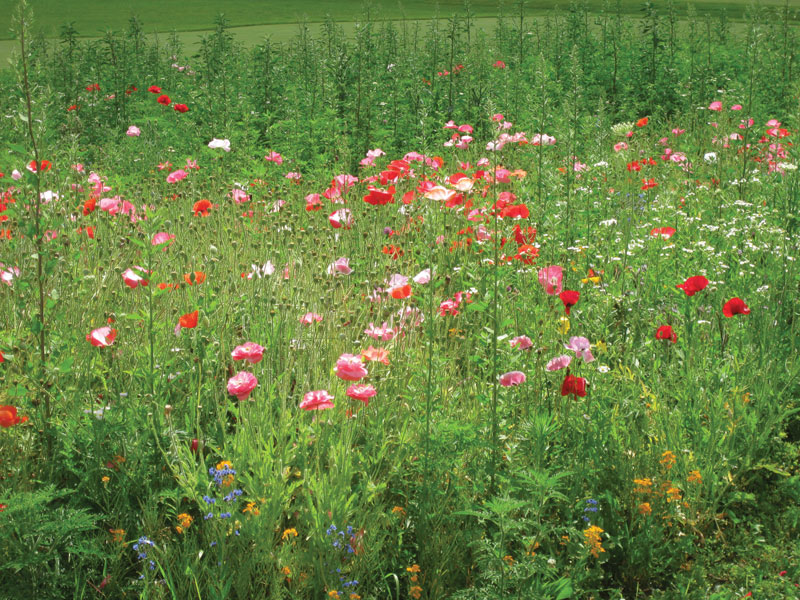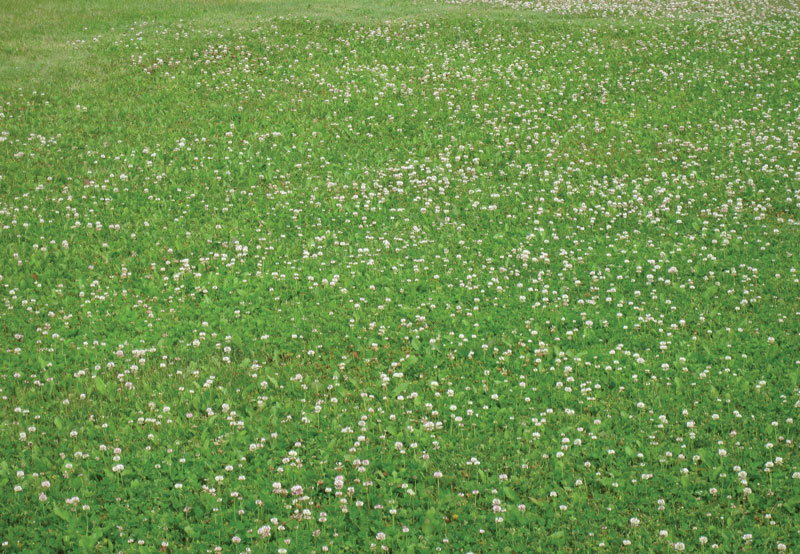
A honey bee flying toward a cuphea flower. Photo by Jim Eklund/USDA-ARS
Turfgrass is an important cropping system covering more than 39 million acres (~16 million hectares) in the United States (9). Synthetic pesticides — including fungicides, herbicides, insecticides and plant growth regulators — are important tools in managing turf landscapes. However, some of these management tools have been implicated in the decline of managed and wild pollinators. Often, the public perception that use of these control agents is linked to pollinator decline threatens future use of these tools and our ability to maintain functional, high-quality turf.
Extension and research entomologists from across the United States met in 2016 at the Summit for Protecting Pollinators in Turf to review the scientific literature on non-target impacts of pest management practices on pollinators in the turfgrass landscape, with the goal of developing best management practices (BMPs) to protect pollinators, identify knowledge gaps, and prioritize future research needs. The working group identified the limited research that exists in turf landscapes, and prioritized areas where research is needed to conserve pollinators while balancing the needs for maintaining healthy, high-quality turfgrass.
What to do about pollinator decline?
The ecological services that native and managed bees and other pollinating insects provide to society are invaluable. It is estimated that 75% of the world’s food crops could not reproduce without assistance from pollinators (5). Unfortunately, pollinator populations have experienced significant declines in the past few decades, ultimately threatening the world food supply. Several factors have been implicated in their decline, including habitat loss, extreme temperature fluctuations (variability), pathogens, parasites, colony stressors and pesticide exposure (3).

Without disturbing the game or the golf course patrons, facilities can establish out-of-play areas on the grounds that are attractive and provide pollinator habitat. Photo by Chris Williamson
Regardless of the numerous factors associated with pollinator decline, the popular press and public often wrongly perceive insecticides — especially neonicotinoids — as the primary threat responsible for pollinator decline. This negative perception has contributed to the imposition of bans on the use of neonicotinoids for aesthetic purposes (including turfgrass management) by several municipalities in the United States. These bans illustrate the need for the development of rational, science-based recommendations for best management practices that promote healthy turf while conserving and enhancing pollinator health.
BMPs for implementing chemical controls in turfgrass
Turfgrass managers have been implementing integrated pest management (IPM) practices for decades to maximize pest management efficiency and efficacy while reducing potential adverse or non-target effects on natural enemies and beneficial organisms (4). Turfgrass managers can employ similar principles to mitigate potential risks to pollinators.
First and foremost, merely following the pesticide label and ensuring that pollinators are not directly exposed to pesticide residues can minimize potential negative impact to pollinators. Other best management practices — including action before, during and after pesticide applications — are often simple and inexpensive.
Pre-application considerations
Applying insecticides directly to flowers has resulted in pollinator kill, notably when insecticide was applied to blooming linden trees in Oregon in 2013 (10). In the turf ecosystem, flowering weeds are quite common and attractive to various pollinating insects (7). Mowing off the flower heads of weeds such as white clover, dandelion and others before pesticide (insecticide) application is recommended in order to avoid the issues associated with direct floral contamination. Evaluation of nectar in turfgrass weed flowers treated with neonicotinoids suggests that if new flowers regrow in treated areas, the residues detected in the new flowers will be below the levels thought to be hazardous or harmful to pollinators (8). Consequently, where turfgrass weeds are mowed regularly, application of pesticides (including neonicotinoids) does not pose a prolonged systemic hazard to bees.
Timing pesticide applications
Turfgrass managers should be mindful of the timing of pesticide applications. Timing can determine the likelihood of pollinator exposure to pesticides, especially insecticides. Most pesticide applications, including insecticides, are applied preventively from March through June (4). Unfortunately, such preventive application timings coincide with the blooming of flowering weeds that frequently attract numerous species of pollinating insects. Simply delaying the application of pesticides (insecticides) while small and vulnerable colonies of honey bees and bumble bees are recovering from winter stress can dramatically reduce the likelihood of potential exposure to toxic insecticides.

Preventive pesticide applications often coincide with blooming of flowering weeds that attract pollinating insects. Mowing blooming weeds to remove flower heads before application of liquid pesticides will significantly reduce the possibility of harm to pollinators. Photo by Chris Williamson
Turfgrass managers can also minimize the potential risk of pesticide exposure to pollinators by applying pesticides only in the early morning or early evening, when most pollinator species are not actively foraging. Making pesticide applications during these time periods can also mitigate the potential risk of spray (pesticide) drift to areas that likely support high populations of foraging pollinators (1).
Pesticide product formulation
The extent to which a pesticide is hazardous to pollinators is also largely affected by the formulation of the product, not just the active ingredient (11). Pesticides used in turf are available in various formulations, including liquid sprays and granules. These formulations vary in their potential to affect pollinating insects (2).
A research study compared sprayable with granular formulations of neonicotinoids when both were applied to flowering weeds in turf. Results showed that the risk of pesticide exposure to pollinators was lower with granular formulations than with sprayable formulations (7). Although both the liquid and granular products are systemic, the granular formulation is less likely to contaminate flowering portions of blooming plants. Even though applying liquid pesticides to blooming or flowering weeds poses a greater risk of pesticide exposure to pollinators, this negative interaction can be avoided by applying post-treatment irrigation or removing flowering weeds by mowing (7).
Post-application turf care
Product labels often require post-treatment irrigation, especially for management of below-ground insects such as white grubs. Irrigation can also remove or dislodge pesticide residues from pollinator foraging zones of treated plants and dilute the active ingredient concentrations, thus reducing potential hazards to pollinating insects (2,6). It has been suggested that irrigation — particularly in the morning — may dilute residues of insecticides present in dew or guttation droplets that frequently accumulate on turfgrass (8).
Conclusions
Pesticides — including fungicides, herbicides, insecticides and plant growth regulators — are valuable tools that allow the turfgrass industry to provide the high-quality turf that the public demands. In order to preserve and protect these valuable tools, the turfgrass industry must use them correctly — in accordance with pesticide labels, EPA guidelines and university recommendations.
Public perception that pesticides are the primary factor responsible for pollinator decline has already resulted in the phaseout of certain insecticides for turfgrass use. It is imperative that the turfgrass industry employ pesticide stewardship and best management practices to protect and preserve pollinators.
Acknowledgments
I extend my appreciation to Adam Dale, University of Florida; David Held, Auburn University; Johnathan Larson, University of Nebraska; Ben McGraw, Penn State University; Doug Richmond, Purdue University; and Kyle Wickings, Cornell University, for their contributions to and authorship of the manuscript (Larson et al. 2017) on which this article is based. I also thank all the attendees of the 2016 Summit for Protecting Pollinators in Turf in Sheboygan, Wis.
Additional reading: Pollinator best management practices
For additional information regarding BMPs for protecting pollinators in turf, see one or all of the following Extension publications:
The research says ...
- Pollinators are valuable natural resources that are responsible for much of the world’s food production, but their numbers are declining.
- The causes of pollinator decline are numerous, and public opinion often places the blame on insecticides.
- By following best management practices for use of insecticides and other turf care products, turf managers can reduce the risk of harm to pollinators.
- Applying pesticides according to label instructions and in accordance with EPA guidelines and university recommendations will help protect pollinators and the environment.
Literature cited
- Bayer Environmental Science. 2012. Canadian Merit label. https://bayeres.ca/files/bayeres/Labels/Merit%20Solupak%202012.pdf
- Gels, J.A., D.W. Held and D.A. Potter. 2002. Hazards of insecticides to bumble bees, Bombus impatiens (Hymenoptera: Apidae) foraging on white clover in turf. Journal of Economic Entomology 95:722-728. doi:10.1603/0022-0493-95.4.722
- Goulson, D., E. Nicholls, C. Botias and E.L. Rotheray. 2015. Bee declines driven by combined stress from parasites, pesticides and lack of flowers. Science 347:1255957. doi:10.1126/science.1255957
- Held, D.W., and D.A. Potter. 2012. Prospects for managing turfgrass pests with reduced chemical inputs. Annual Review of Entomology 57:329-354. doi.org/10.1146/annurev-ento-120710-100542
- Klein, A.M., B.E. Vassiere, J.H. Cane, I. Steffan-Dewenter, S.A. Cunningham, C. Kremen and T. Tscharntke. 2007. Importance of pollinators in changing landscapes for world crops. Proceedings of the Royal Society B: Biological Sciences 274:303-313. doi:10.1098/rspb.2006/3721
- Kunkel, B.A., D.W. Held and D.A. Potter. 2001. Lethal and sublethal effects of bendiocarb, halofenozide and imidacloprid on Harpalus pennsylvanicus (Coleoptera: Carabidae) following different modes of exposure in turfgrass. Journal of Economic Entomology 94:60-67. doi:10.1603/0022-0493-94.1.60
- Larson, J.L., A.J. Keisheimer and D.A. Potter. 2014. Pollinator assemblages on dandelions and white clover on urban and suburban lawns. Journal of Insect Conservation 18(5):863-873. doi.org/10.1007/s10841-014-9694-9
- Larson, J.L., C.T. Redmond and D.A. Potter. 2015. Mowing mitigates bioactivity of neonicotinoid insecticides in nectar of flowering lawn weeds and turfgrass guttation. Environmental Toxicology and Chemistry 34:127-132. doi:10.1002/etc.2768
- Milesi, C., C.D. Elvidge, J.B. Dietz, B.T. Tuttle, R.R. Nemani and S.W. Running. 2005. Mapping and modeling of biogeochemical cycling of turf grasses in the United States. Environmental Management 36:426-438. doi.org/10.1007/s00267-004-0316-2
- Mohney, G. 2013. More than 25,000 bees die in Oregon. (http://abcnews.go.com/blogs/headlines/2013/06/more-than-25000-bees-die-in-oregon) Accessed April 2, 2018.
- Stark, J.D., P.C. Jepson and D.F. Mayer. 1995. Limitations to use of topical toxicity data for predictions of pesticide side effects in the field. Journal of Economic Entomology 88:1081-1088. doi.org/10.1093/jee/88.5.1081
R. Chris Williamson is a professor and Extension specialist at the University of Wisconsin-Madison.